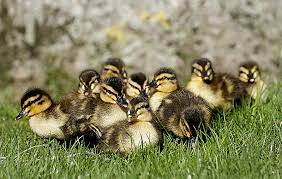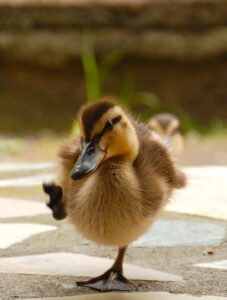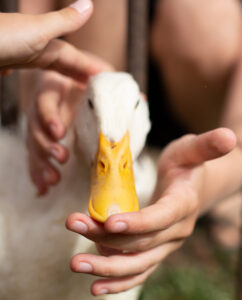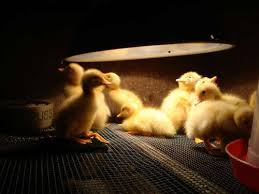Baby ducklings have the remarkable ability to find their ideal zone of warmth in the brooder. A good tip is to simply note your duckling’ positions in the brooder box, you’ll know whether the temperature in the brooder is too hot, not warm enough, or just right.
NOTE: ducklings do not take heat well, so be sure not to overheat them. They like a temperature of 90-92 degrees for the first 3 days, then 85-90 degrees for days 4 to 7. Thereafter, drop the temperature by approximately 5 degrees per week until they are fully feathered.
http://www.grangecoop.com/how-to-raise-your-baby-ducks-and-geese/
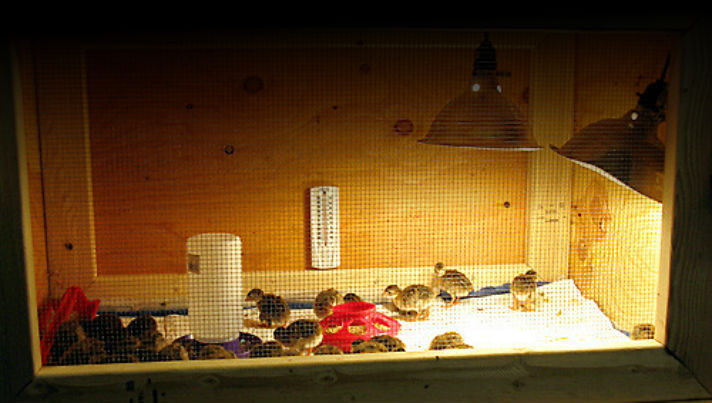
Temperature Correct
If the heat level is just right, ducklings will be evenly spread throughout the brooder. With adequate food and fresh water, you’ll hear them making contented peeping sounds.
Temperature Too High
If your ducklings are spread out around the perimeter of the brooder the temperature is likely too high. You could try raising the heat lamp another couple of inches. Another option is to switch to lower wattage bulbs.
The ducklings will be silent and you may notice them panting and heads drooping.
Temperature Too Low
If the brooder is too cool, ducklings will huddle together directly under the heat lamp. They will be noisier than normal, which is a sign of distress. Lower the lamp closer to the floor of the brooder and/or put in higher watt bulbs.
Other Problems
Chicks huddled together in one spot on the perimeter of the brooder suggests they are uncomfortable and requires investigation.
This distribution may be caused by a draft, external noises that are scaring them or uneven light distribution.
Warmth is critical to baby ducklings, but their need for artificial heat diminishes as they age.
So how do you know if your brooder is the right temperature for your new ducklings? In addition to noting your ducklings’ positions in the brooder, a thermometer is a great tool.
RECOMMENDED PRODUCT: Infrared Thermometer
Theoretically, chick brooder temperature is measured with a thermometer placed 2 inches (5 cm) above the brooder floor. But I can say from exprience that this is a NIGHTMARE
The ducks continue to knock it over or move it, so an infrared thermometer (you simply point and measure the temp) is a lifesaver. I highly recommend it!
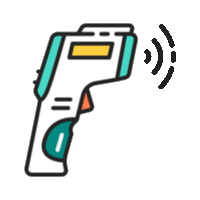
Here’s a good one that will last you a long time from Pets Warehouse
Brand new baby ducklings prefer temperatures just under 100 degrees. However, their need for heat decreases about 5 degrees per week until they are about 10 weeks of age.
Approximate Heat Needs by Age
| Timeline | Temperature |
|---|---|
| First 10 Days | 98 degrees Fahrenheit |
| Days 11 – 17 | 93 degrees Fahrenheit |
| Days 18 – 24 | 88 degrees Fahrenheit |
| Days 25 – 31 | 83 degrees Fahrenheit |
| Days 32 – 38 | 78 degrees Fahrenheit |
| Days 39 – 45 | 73 degrees Fahrenheit |
Where to Place Lamps?
Suspend two lamps, each fitted with an incandescent 60-watt bulb, 12-18 inches above the floor of the brooder. Gooseneck lamps work, or infrared heat lamps can be purchased at your feed dealer. These can be fitted with special heat bulbs, but often an incandescent bulb will produce enough heat.
How Many Lamps?
Two lamps are important. If one burns out in the wee hours of the night, the other will keep the ducklings warm until morning. Placing a sheet of cardboard over the brooder helps retain heat, but be very cautious about keeping anything flammable away from hot bulbs.
